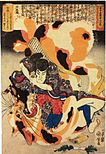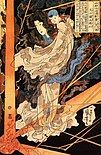User:AlexDoolittle2/Nansō Satomi Hakkenden
| This is the sandbox page where you will draft your initial Wikipedia contribution.
If you're starting a new article, you can develop it here until it's ready to go live. If you're working on improvements to an existing article, copy only one section at a time of the article to this sandbox to work on, and be sure to use an edit summary linking to the article you copied from. Do not copy over the entire article. You can find additional instructions here. Remember to save your work regularly using the "Publish page" button. (It just means 'save'; it will still be in the sandbox.) You can add bold formatting to your additions to differentiate them from existing content. |
Intro[edit]
Nansō Satomi Hakkenden (shinjitai: 南総里見八犬伝; kyūjitai: 南總里見八犬傳) is a Japanese epic novel (yomihon) written and published over twenty-eight years (1814-42) in the Edo period, by Kyokutei Bakin. Set in the Muromachi period, the story follows eight fictional warriors, connected spiritually but born into different families throughout the Kantō region, coming together and fighting as vassals of the Satomi clan; as well as numerous side plots.
The novel, consisting of 98 chapters printed in a total of 106 booklets, is considered the largest novel in the history of Japanese Literature.[1] Along with Ueda Akinari's "Ugetsu Monogatari", it is considered a masterpiece of gesaku literature, and one of the classics of Japanese historical fiction.[1] The title has been translated as The Eight Dog Chronicles,[2] Tale of Eight Dogs,[3] or Biographies of Eight Dogs.[4]
Plot[edit]

Nansō Satomi Hakkenden is a novel about the tale of eight youngsters (The Eight Dog Warriors) bound by a fateful connection in another world between Princess Fuse, a princess of the Satomi clan in Awa, and the dog of kami Yatsufusa, set in the late Muromachi period (350 years before Bakin lived). The eight Dog Warriors, who commonly have family names including the character for '犬' (Inu, dog) each have a peony shaped bruise somewhere on their body and a bead of Japamala with the characters for humanity, justice, courtesy, wisdom, loyalty, sincerity, filial piety and obedience. Born in various parts of the eight provinces of Kanto region, they get to know each other guided by the fate of each other while experiencing hardship, and gather together under the Satomi clan. They served the Satomi clan and fought against the allied forces of powerful feudal lords, and the story came to an end. The themes of their adventures are loyalty, clan honor, Bushido, Confucianism, and Buddhist philosophy.[5]
Inception[edit]
Bakin was heavily inspired by Chinese vernacular fiction, especially Water Margin, which had been translated and published in Japan at the beginning of the 18th century.[6] Bakin most frequently referred to Nansō Satomi Hakkenden's genre as Haishi (commonly translated as petty history, or people's history), a Chinese genre of vernacular historical fiction.[7] Bakin often stated that the primary purpose of the novel was to encourage virtue and chastise vice, which was central to the novel's plots and character archetypes; likening himself to the authors of Haishi in that he used entertaining stories to entice less-educated readers, who would, in turn, be taught morals through allegory.[8][9] As a work of gesaku, however, the novel also contains tacit social commentary, and often plays with traditional concepts relating to gender and morality.[10]
History of Reception[edit]
Although only a limited number of copies of the books themselves were printed, the tale was retold through various mediums, including oration and live performance, leading to its popularity among many social classes at the time. Kabuki plays based on Hakkenden were often performed, and ukiyo-e depicting kabuki actors playing the roles of eight warriors were also popular.
-
Inukawa Sōsuke. The One and Only Eight Dog History of Old Kyokutei, Best Refined authors. by Utagawa Kuniyoshi.
-
Inumura Daikaku. The One and Only Eight Dog History of Old Kyokutei, Best Refined authors. by Utagawa Kuniyoshi.
-
Princess Fuse saving Inue Shimbyoe Masahi from a thunderbolt. by Utagawa Kuniyoshi
-
Inudzuka Shino on Hōryūkaku roof looking down on Inukai Kenpachi with geese flying below full moon. by Utagawa Kuniyoshi
-
Actor Nakamura Tamasuke I (Nakamura Utaemon III) as Moriguchi Kurō, a Valiant Retainer of Satomi Yūshin. by Utagawa Kunisada II
Hakkenden, and Bakin's work at large, maintained much of its popularity amongst common people throughout the 19th century, but drew some academic criticism in the Meiji Era for its didacticism and one-dimensional characters, as novelists and scholars sought to modernize Japan's literary style.[11] Notably, in literary reformer Tsubouchi Shōyō's influential book, Essence of the Novel, published 1885-1886, Bakin is lauded for both his style and his role in popularizing novels, but imitation of Bakin's work is cited as a widespread problem among novelists of the time.[12]
A complete reprinting in ten volumes is available in the original Japanese, as well as various modern Japanese translations, most of them abridged. Only a few chapters have been translated into English, Chapter 25 by Donald Keene,[1] Chapters 12, 13, and 19 by Chris Drake,[2] and in 2021 the first volume of a translation by Glynne Walley, titled Eight Dogs, or "Hakkenden" Part One - An Ill-Considered Jest was published by Cornell University Press.[13]
Adaptations and Influenced Works[edit]

In live-action film and TV there have been numerous adaptions: the first in 1913, then a series in the 1950s, and since the influential TV series Shin Hakkenden (ja:新八犬伝) from the early 1970s, every decade has had either a live-action adaptation or a show significantly influenced by the novel, right up through the 2010s.
The novel has also been adapted into kabuki theatre several times.[14] In August 2006, the Kabuki-za put on the play.[15] In 1959, the TOEI motion picture company made Satomi hakken-den.[16] In 1983, the novel was loosely adapted into the film Legend of the Eight Samurai.
Hakkenden has had a strong influence on modern manga and anime works, particularly those based on adventure quests. For example, it influenced Akira Toriyama's Dragon Ball (1984) and Rumiko Takahashi's Inuyasha (1996), which both have plots about the collection of magical crystals or crystal balls.[17]
- ^ a b Japanese wiki page ja:南総里見八犬伝
- ^ Shirane, Haruo (2002). Early Modern Japanese Literature: an Anthology, 1600-1900. Columbia University Press. p. 886. ISBN 0-231-10990-3.
- ^ Rimer, J. Thomas (2007). The Columbia Anthology of Modern Japanese Literature: From Restoration to Occupation, 1868-1945. Coughlan Publishing. p. 196. ISBN 978-0-231-11861-3.
- ^ Keene, Donald (1955). Anthology of Japanese Literature, From the Earliest Era to the Mid-Nineteenth Century. Grove Press. p. 423. ISBN 0-8021-5058-6.
- ^ Kotobanlk, Nansō Satomi Hakkenden. The Asahi Shimbun
- ^ Shirane and Brandon, Early Modern Japanese Literature, p564.
- ^ Takizawa, Bakin (2021). Eight dogs, or "Hakkenden". Part I : an ill-considered jest, Chapters I through XIV of Nansō Satomi Hakkenden. Glynne Walley. Ithaca [New York]. ISBN 978-1-5017-5519-4. OCLC 1224043076.
{{cite book}}: CS1 maint: location missing publisher (link) - ^ Yamamoto, Yoshitaka (2019). "Good Dogs: Edification, Entertainment, and Kyokutei Bakin's "Nansō Satomi hakkenden." by Glynne Walley". Monumenta Nipponica. 74 (1): 101–106. doi:10.1353/mni.2019.0022. ISSN 1880-1390.
- ^ Walley, Glynne (2012). "Gender and Virtue in Nansō Satomi hakkenden". Harvard Journal of Asiatic Studies. 72 (2): 337–371. doi:10.1353/jas.2012.0020. ISSN 1944-6454.
- ^ Early modern Japanese literature : an anthology, 1600-1900. Haruo Shirane, 治夫 白根. New York: Columbia University Press. 2002. p. 888. ISBN 0-231-10990-3. OCLC 48084101.
{{cite book}}: CS1 maint: others (link) - ^ Dowdle, Brian C. (2016). "Why Saikaku Was Memorable but Bakin Was Unforgettable". The Journal of Japanese Studies. 42 (1): 91–121. doi:10.1353/jjs.2016.0009. ISSN 1549-4721.
- ^ Tsubouchi, Shōyō (1885–1886). Shōsetsu Shinzui: The Essence of the Novel. Translated by Twine, Nanette.
{{cite book}}: CS1 maint: date format (link) - ^ "Eight Dogs, or "Hakkenden"". Cornell University Press. Retrieved 2021-09-09.
{{cite web}}: CS1 maint: url-status (link) - ^ "Nansô Satomi Hakkenden". kabuki21.com. Retrieved 3 March 2018.
- ^ "AUGUST 2006". www.kabuki21.com.
- ^ Satomi hakken-den at IMDb
- ^ Papp, Zília (2010). Anime and Its Roots in Early Japanese Monster Art. Global Oriental. p. 38. ISBN 978-90-04-20287-0.





